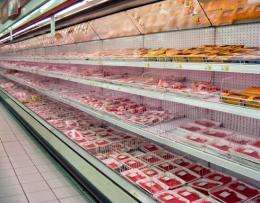Climate change makes food more dangerous

Global warming has the potential to make what we eat more dangerous and expensive, and the world already is feeling the effects, according to experts.
A quartet of scientists reporting during the annual meeting of the American Association for the Advancement of Science in Washington last weekend said the issues of food safety are poorly understood, but the inference from what is known is distressing.
They fear that global warming would lead to increased levels of contamination of food, from chemicals and pesticides to crop pests and fungal pathogens, as well as faster spreading of diseases such as cholera and shellfish poisoning. These issues could also force changes in diets as some foods become less available or more dangerous and increase food prices in a world where they are already rising and causing civil unrest.
Discussions about the link between climate change and food safety are only now beginning, said Sandra Hoffman of the Department of Agriculture, and the science is not clear.
While poor countries, particularly in the tropics and subtropics and the impoverished everywhere will fare the worst, according to Ewen C. Todd, of Michigan State University in East Lansing, Mich., the threat is not restricted to the developing world.
There are 38.4 million cases of food poisoning in the U.S. every year, mostly from noroviruses, the pathogen best known for affecting cruise ship passengers. Of those victims, 72,000 people are hospitalized and 1,600 die. Salmonella, a bacterium, now is the leading cause of food-related death.
Scientists know that for every degree the ambient temperature rises above 6 degrees Celsius -- or 43 degrees F -- temperature in an area, the occurrence of food-borne salmonella poisoning increases by 12 percent.
The dangers can readily be demonstrated, Todd said. In 2005, lettuce grown in Spain and shipped to Finland caused 56 cases of salmonella poisoning. The cause was traced to farmers using untreated water for irrigation. They had to do so, they told authorities, because a drought, likely produced by climate change, restricted their access to clean water.
Another possible effect of climate change is in the news now. One of the reasons for the unrest in Egypt and Asia has been rising food prices caused by stressed ecosystems on the land and in the ocean, Todd said.
Ray Knighton, also of the USDA, said changing climate affects food production. Drought can cause a loss in plant vigor, making plants more susceptible to disease; floods and heavy rains favor the growth of fungal pathogens on leaves, and many disease-causing organisms can spread in changing wind currents.
"Greenhouse gasses and atmospheric pollutants change plant structure and the ability of the plant to defend itself against pathogens," he said.
Most scientists believe climate change is producing more severe storms and these apparently help spread diseases.
One classic example is Asian soybean rust, spores that cause gold speckles on the light green leaves and eventually kill the plant. The spores spread from Asia to Africa then to South American and finally the United States. The spread in the U.S. was unusually fast and wide. It turns out the spores were riding on the winds of hurricanes from the Gulf of Mexico, Knighton said.
That has huge implications for how food-borne diseases are monitored and the need for a sensitive network for tracking pathogens, he said.
Vibriosis, which comes from seafood, is known to increase with rises in the temperature and salinity of the oceans, said Hoffman. It peaks in the heat of summer. One species of the vibrio bacteria causes cholera. As temperatures rise, the implication is that the spread of vibriosis also will rise.
Increased water temperatures also can lead to increased mercury contamination of fish by 30-50 percent for every increase in degree Celsius, said Cristina Tirado of the University of California at Los Angeles. Desertification, another probable result of climate change, increases pesticide concentration in plants, she said. Flooding leads to soil contamination, and even biofuel production could be affected.
The danger of food poisoning could mean people change what they eat, Tirado added, avoiding foods grown where climate change has altered the path of germs and potentially increasing the price of food. One and a half billion people already pay 80 percent of their income for food and an increase in food prices would mean "more hunger and less money for health care and education."
The scientists admitted a contradictory effect of climate change: the possibility that some areas, particularly in the north, not now able to grow extensive crops, will warm up and begin to grow more food. Additionally, the cause and effect between climate change and food security is not well-defined.
Part of the problem, Hoffman said, is that data on the incidence of foodborne disease is imprecise and hard to come by.
"There is significant uncertainty about all of this," Hoffman admitted. "We don't know what direction those cumulative effects will be." That uncertainty, she said, will make difficult to design an effective adaptation policy.
Provided by Inside Science News Service


















